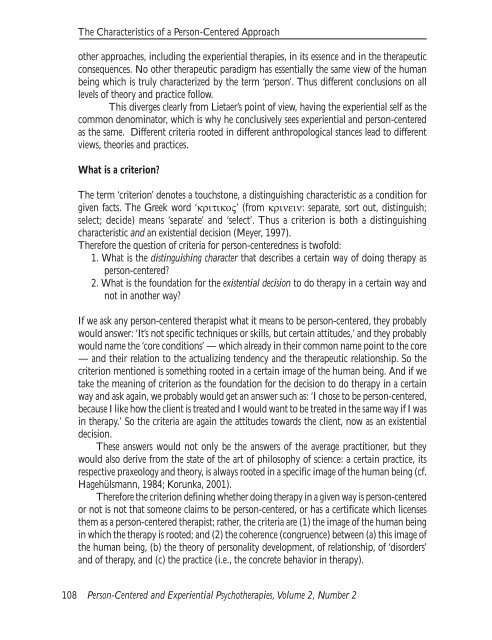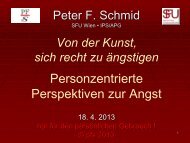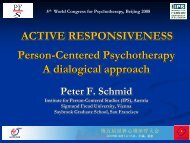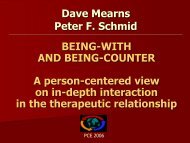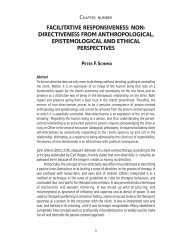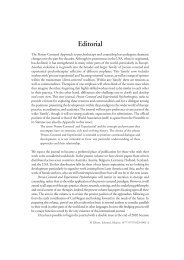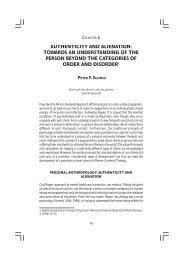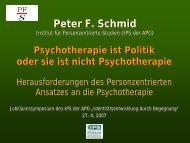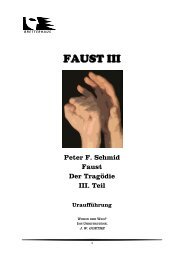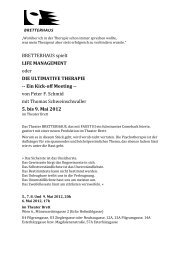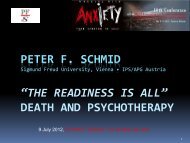The Characteristics of a Person-Centered ... - Peter F. Schmid
The Characteristics of a Person-Centered ... - Peter F. Schmid
The Characteristics of a Person-Centered ... - Peter F. Schmid
- No tags were found...
Create successful ePaper yourself
Turn your PDF publications into a flip-book with our unique Google optimized e-Paper software.
<strong>The</strong> <strong>Characteristics</strong> <strong>of</strong> a <strong>Person</strong>-<strong>Centered</strong> Approachother approaches, including the experiential therapies, in its essence and in the therapeuticconsequences. No other therapeutic paradigm has essentially the same view <strong>of</strong> the humanbeing which is truly characterized by the term ‘person’. Thus different conclusions on alllevels <strong>of</strong> theory and practice follow.This diverges clearly from Lietaer’s point <strong>of</strong> view, having the experiential self as thecommon denominator, which is why he conclusively sees experiential and person-centeredas the same. Different criteria rooted in different anthropological stances lead to differentviews, theories and practices.What is a criterion?<strong>The</strong> term ‘criterion’ denotes a touchstone, a distinguishing characteristic as a condition forgiven facts. <strong>The</strong> Greek word ‘κριτικος’ (from κρινειν: separate, sort out, distinguish;select; decide) means ‘separate’ and ‘select’. Thus a criterion is both a distinguishingcharacteristic and an existential decision (Meyer, 1997).<strong>The</strong>refore the question <strong>of</strong> criteria for person-centeredness is tw<strong>of</strong>old:1. What is the distinguishing character that describes a certain way <strong>of</strong> doing therapy asperson-centered?2. What is the foundation for the existential decision to do therapy in a certain way andnot in another way?If we ask any person-centered therapist what it means to be person-centered, they probablywould answer: ‘It’s not specific techniques or skills, but certain attitudes,’ and they probablywould name the ‘core conditions’ — which already in their common name point to the core— and their relation to the actualizing tendency and the therapeutic relationship. So thecriterion mentioned is something rooted in a certain image <strong>of</strong> the human being. And if wetake the meaning <strong>of</strong> criterion as the foundation for the decision to do therapy in a certainway and ask again, we probably would get an answer such as: ‘I chose to be person-centered,because I like how the client is treated and I would want to be treated in the same way if I wasin therapy.’ So the criteria are again the attitudes towards the client, now as an existentialdecision.<strong>The</strong>se answers would not only be the answers <strong>of</strong> the average practitioner, but theywould also derive from the state <strong>of</strong> the art <strong>of</strong> philosophy <strong>of</strong> science: a certain practice, itsrespective praxeology and theory, is always rooted in a specific image <strong>of</strong> the human being (cf.Hagehülsmann, 1984; Korunka, 2001).<strong>The</strong>refore the criterion defining whether doing therapy in a given way is person-centeredor not is not that someone claims to be person-centered, or has a certificate which licensesthem as a person-centered therapist; rather, the criteria are (1) the image <strong>of</strong> the human beingin which the therapy is rooted; and (2) the coherence (congruence) between (a) this image <strong>of</strong>the human being, (b) the theory <strong>of</strong> personality development, <strong>of</strong> relationship, <strong>of</strong> ‘disorders’and <strong>of</strong> therapy, and (c) the practice (i.e., the concrete behavior in therapy).108 <strong>Person</strong>-<strong>Centered</strong> and Experiential Psychotherapies, Volume 2, Number 2


